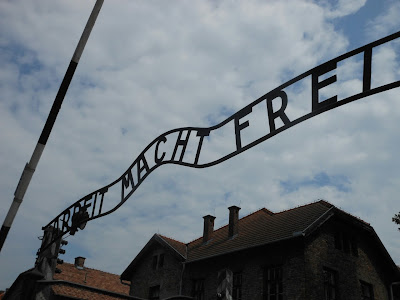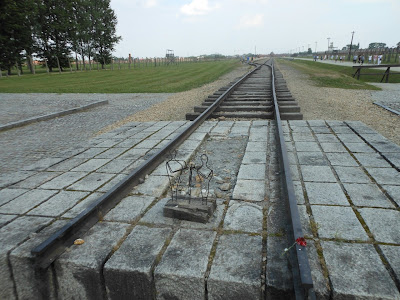Note: This post is pretty depressing. Don't read on if you're not prepared for it.
I think this will be the only post I make that only covers one day. I think the subject matter deserves it.
Just over a week earlier, in Berlin, I spent quite a lot of time exploring the darker side of the city's history. Places like the Memorial to the Murdered Jews of Europe, the Topography of Terror Exhibition, the remnants of the Berlin Wall. Visiting Auschwitz was a very moving complement to those experiences, one that I felt I needed to do, and wanted to do, despite knowing that it would not be a particularly enjoyable day.
Leaving early from my hostel in Katowice, I caught a train to the town of Oświęcim. Oświęcim is the name of the Polish village from which the Germans named the largest concentration camp in World War II - Auschwitz is simply a Germanisation of Oświęcim.
The train was a bit difficult to find - it left from a small back platform of the train station and was only one carriage. Most people take buses from Kraków. Unfortunately that also meant the site was hard to find from the train station. I was headed first for the site of the camp known as Auschwitz I, the original camp set up in an early stage of the war. The massive Auschwitz II-Birkenhau site, nearby, was built later and was much larger, including being in the process of enlargement when the camp was abandoned by retreating Nazis.
Auschwitz I
There was quite a sombre mood from the people heading into the museum located at Auschwitz I. Walking out of the entrance building - previously used by the Nazis for administration - the (in)famous "Arbeit Macht Frei" sign is right there, and suddenly the overwelming magnitude of where I was and what had happened there kinda hit me.
 |
| Arbeit Macht Frei - "Work Makes You Free" - possibly the most depressingly ironic sign in the world |
 |
| Until you look down the end of the row of buildings, to the guard tower, barbed wire and sign. That reminds you where you are pretty quickly. |
One of the most well known (and photographed) is the building containing a collection of items recovered at the site.
 |
| Collection of tins taken from Auschwitz I prisoners |
 |
| Briefcases taken from Auschwitz prisoners |
Block 11, beside it, was an administration building where sentences were passed against prisoners who caused trouble. There are cells beneath the building where one of the punishments involved a tiny cell, about one square metre with a small door below knee height, where up to four (yes, 4) people would be forced to stand for long periods, unable to turn around or sit down.
 |
| Standing cell for up to 4 prisoners who required some sort of punishment |
That just made me shake my head in wonder and disbelief.
After walking through some of the other exhibits - a number of the countries whose population was affected the most have their own exhibits, and I visited the Dutch and Russian ones - I walked out of the row of barracks - through this double barbed wire fence:
 |
| The fence around the barracks - though it didn't used to be able to be possible to walk through |
 |
| The first gassing chamber at Auschwitz (partially reconstructed). The chimney is for the in-build incinerator. |
It was haunting, it was quiet, it was dark, it was scary. It was completely overwhelming.
I lasted about 30 seconds until I had to leave, out into the fresh air. I couldn't stand it any more.
I was time for some relief from this place. I left the Auschwitz I camp and treated myself to some time of normality, away from the thoughts and memories of that place. Some deep breaths, some lunch. And then I headed off in the shuttle bus to the other site, the much larger Auschwitz II-Birkenau.
Auschwitz II-Birkenau
Birkenau was, as I mentioned above, a much larger camp built primarily to assist with the Nazi's "Final Solution to the Jewish Question". This was where the majority of the estimated 1 million Jews murdered at Auschwitz were taken - about one-sixth of all Jews murdered in World War II. Many others were taken here and murdered too.
The large majority of those came straight in a train - the tracks were eventually extended to go right into the camp - down a ramp, and straight into a gas chambers.
This is the site I'm talking about, a very well-known image:
| The very symbolic "Gate of Death" entrance to Birkenau, the train tracks leading directly inside (image borrowed from Wikipedia) |
 |
| The barbed wire fence is all the remains in the back reaches of the fields at Birkenau |
The train lines extend through the length of the site, directly to almost the front doorstep of the four massive gas chambers built for just one purpose - the extermination of the Jewish people, the "Final Solution to the Jewish Question".
 |
| The end of the railway lines, looking down the platforms were new arrivals were sorted into those fit to work, and those to be sent directly to the gas chambers |
Prisoners would enter down a set of stairs into a room where they would be told to undress in preparation for disinfection. They would then enter the "disinfection room" - complete with fake shower heads - with an estimated up to 2,500 people being crammed into the 210 m2 space at once.
 |
| The entrance to one of the gas chambers, where several hundred thousand people would have seen their last light of day |
 |
| The ruins of one of the gas chambers |
Over the space of several years, some one million people were murdered within 200 m of where I was sitting. Their ashes were strewn in the surrounding areas.
How was that possible? How could anyone have let this happen? How could anyone have denied the basic human right to live to anybody? How did the Final Solution to the Jewish Question manage to become so far progressed?
As I walked past the nearby memorial, I couldn't come up with an answer to any of those questions.
I couldn't help but think that the warning to humanity referred to on the plaque will not be heeded forever. I could feel the cry of despair.





















































